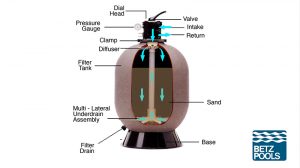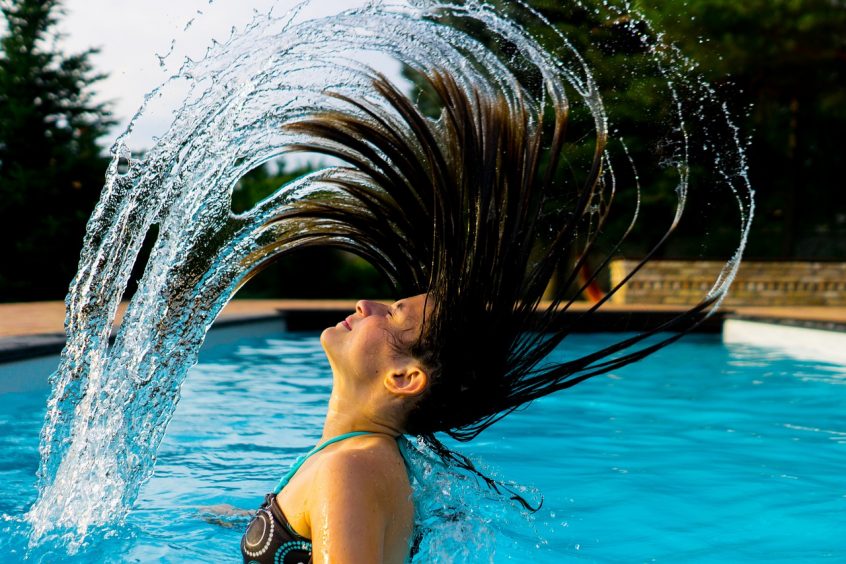The three keys to a clean and healthy pool are circulation, chemistry, and filtration. The latter is commonly overlooked when problems arise, however. Circulation usually is not a problem since most pools are designed with properly sized pumps, filters, plumbing (pipes), and proper placement of skimmers, and returns. In most cases, water chemistry is the initial cause of problems, such as green or cloudy pool water, but it can be easily remedied. After the water is properly balanced, water clarity should improve within a day or two. However, if the water does not clear up there may be filter issues.
The sands of time

Figure 1: A sand filter dissected.
As a service professional, this author’s favorite type of filter is the sand filter. Of all the other types of filters (e.g. cartridge, diatomaceous earth [DE]), sand filters are efficient with a minimum amount of maintenance, but as with all equipment, there can be issues.
For those new to the pool industry, the following is a quick explanation of how sand filters work (see Figure 1). The pump draws water from the pool and pushes it to the filter. The water enters via the dial valve, travels through the diffuser, then through the sand bed. As the water passes through the sand, the debris is caught between the sand particles. The filtered water then enters the filter lateral assembly at the bottom of the filter, travels up the stand pipe and back out the filter to be returned to the pool.
This is just a warning
Common warning signs of potential filter issues are the need for frequent backwashing, sand returning to the pool, low or high filter pressures, and water leaking at the dial head through the backwash line. The most common problem, however, is lack of proper maintenance. Quite often it is the result of overlooking an annual chemical cleaning of the sand, or it could be because the filter is due for a sand change.
Backwashing
Filters should be cleaned by backwashing when the pressure increases by 34.5 to 68.9 kPa (5 to 10 psi), or weekly by a service professional hired to maintain a swimming pool. A yearly filter cleaning with a chemical cleaner will also help to remove scale, greases, and oils from the filter sand.
Replacing sand
Changing the sand in the filter should be done every six to seven years. This author has seen filters that are still working with the original sand after 20 years, but at a loss of efficiency. What is even more concerning in these cases, however, is once there is a problem it usually requires a full replacement of the filter system. Sand is more efficient at collecting debris when it is new and the particles have course edges. Over time with water passing through the sand, the edges slowly begin to wear down and the grains of sand become round. Once this occurs, fine debris is allowed to pass through the sand, which will lead to cloudy water.
Under pressure
Low filter pressures can be caused when lines are blocked before the filter, while high filter pressures can be caused by blocked lines. In most cases, however, it is usually a sign the sand is beginning to calcify. When this occurs, water is channeling between the filter tank body and the sand bed instead of the unit. High pressures usually lead back to the need to change the sand.
Sand in the pool?
Sand returning to the pool usually means one of the filter laterals at the bottom of the filter is cracked or broken and is allowing sand to escape from the filter. This is likely the cause when pockets of sand are found forming on the pool floor, below the returns.
Do not cut corners
When it comes to the internal workings of sand filters, other articles on this subject will likely instruct service professionals to be extremely careful when removing the sand for fear of breaking the filter laterals. However, the best way to go about it is to always replace the laterals when changing the sand.
It is a large job to replace the sand and it would be disastrous to find out after the project is completed that there was a small crack in the lateral, or the filter has started to return sand to the pool. A new filter lateral assembly is a small cost for the customer to ensure they will not have a problem in the near future.
Another common issue with sand filters is when the dial head leaks water out through the backwash line (when the dial is set in the filter position). This is normally fixed by simply replacing the spider gasket in the filter dial head.
Additional advice
The following are a few other tips for service professionals to help maintain sand filters. First, always remove any old Teflon tape on plugs or filter gauges when they are being replaced. Silicone should be used whenever possible as it is less likely to cross thread the plugs or gauges. With clean threads never use Teflon tape. Most importantly, make sure the water is draining from the filter when winterizing the equipment. In the spring, the last thing the homeowner will want to see is a cracked filter they will have to replace.
This article was written by Brian Lilleberg and originally appeared on Pool & Spa Marketing [link].
